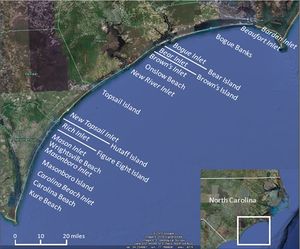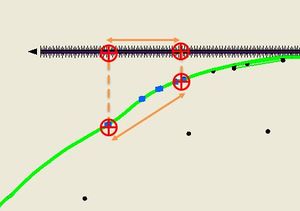Onslow Bay, NC, Lessons Learned
The Onslow Bay project began in 2009 in conjunction with the development of the very first draft code of GenCade. The project itself was the first application of GenCade and has served over the years as the go-to case to test any new features or capabilities with real-life scenarios. The Onslow Bay area has proven to be a very difficult area to model and in that sense has provided the GenCade development team an opportunity to test any changes to the code. This case has helped make GenCade more robust. The project was completed in July 2012, a few months after the official release of GenCade V1. This article will highlight the lessons learned and aspects of the project that were not discussed in the official documentation. The project was discussed in this CHETN and further detailed in this Journal article (not yet published). In addition the final presentation prepared for the Wilmington District provides more figures and hypothetical scenarios.
Background

Onslow Bay in North Carolina, is a crescentic series of barrier islands covering more than 100 miles of beaches between Cape Lookout and Cape Fear (figure 1). The curvature of the Bay is very pronounced resembling a quarter circle; the curvature was one of the first obstacles encountered during the setup of the model and is further discussed in the Multiple Grids chapter.
The narrow barrier islands are separated by 11 inlets, most of which are unstructured and migrating. The first step of the study was to conduct a literature review of the area; the process is further described in the Book Keeping and Data Management chapter.
Of the 11 inlets, only Beaufort and Masonboro Inlets are structured. To the north to the Bay, Beaufort Inlet is a large federally maintained deep draft channel supplying Morehead City Harbor. Because the area is well studied and politically sensitive, it has required special attention during the calibration process which will be further detailed in the Beaufort Inlet section.
The southern portion of the bay also had its fair share of challenges mostly due to the variation in the bottom geology. The strategy to overcome this issue is described in the Underlying Geology section.
Book Keeping and Data Management
Before starting a GenCade project, it is essential that the modeler possesses a general feel for the transport direction and magnitude over the area and also a general knowledge of the data available (shorelines, engineering activities, etc). The first task was to look for existing transport studies and to hunt for repertories of beach nourishment and dredging activities. Although some areas were well studied and documented such as Bogue Banks to the north and Wrightsville Beach and Carolina Beach to the south, little was known for most of central portion of the bay. To facilitate the book keeping of the data, it was decided to divide the project into three areas, the north, the central and the south portion. Once this was done, it became more manageable to research and documents the data available.
Shorelines, wave data, berm height, and grain size are usually easy to find. However beach nourishment and dredging activities require special attention. It is recommended to keep an inventory of the engineering activities for the simulation period organized in a spreadsheet. For beach fills, column for dates, location and volume/width placement will be needed. Always list the reference next to the data. List all structures such as groins, seawalls, etc with their characteristics including the date of construction. A separate tab should be dedicated to the inlets. Inventory dredging activities for each inlet with date and volume as well as the morphological feature dredged (ebb shoal, bypassing bars, etc.). If many inlets are present in the domain, it can be useful to have all the known and unknown information regarding the shoals volume listed (equilibrium and initial). Lastly during the literature process, it is useful to keep a summary of the key points of a particular report. Information such as estimated bypassing rate, observed erosion/accretion rate, transport direction/rate, inlet migration, and ebb shoal volume should be logged in a document (with references). During the validation of results, it is very convenient to have all of the information in one place. A well organized dataset will facilitate the work of teammates that might come in later on the project, minimize the risk of omitting important aspects, and make documentation much easier.
Multiple Grids

It became evident early on in the project that the large curvature of the bay would make modeling the entire domain with a single grid a challenge. One issue comes from the fact that internally the wave direction used by the GenCade executable must be in the shore-normal convention. The conversion from meteorological convention to shore-normal is made by the interface. Because of the large variation in shoreline orientation, the grid azimuth is used to provide the baseline to perform the conversion. After conversion, the waves really are oriented “grid-normal” and any waves exceeding +/-90 degrees are not considered. When using a single grid oriented NE-SW for the entire Bay, the angle between the grid and the shoreline can become up to 40 degrees at the extremities (figure 2). This means that waves coming in a certain angle are not considered which affect the transport direction. Test runs made with a single grid had shown to produce unrealistic transport direction because the waves coming from the west that would be impacting the northern portion of the bay were omitted. However the biggest issue was the instabilities arising from having wave coming at the steep angle with the shoreline at the northern extremities.
Another issue is how skewed the longshore distances become. In the process of making a GenCade grid, feature such as inlets, beach fills and structures will be translated from their real world location to the GenCade 1D grid system by moving them following a perpendicular line to the grid. When the grid does not follow the shoreline orientation distance between object appear closer on the grid (figure 3). For example the distance between Bogue and New River inlet would be 2.3 miles shorter on a horizontal grid than in reality.
